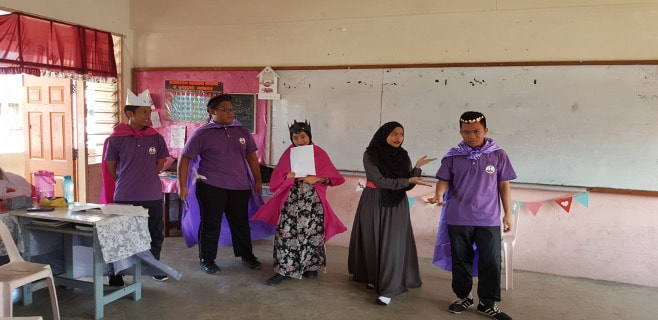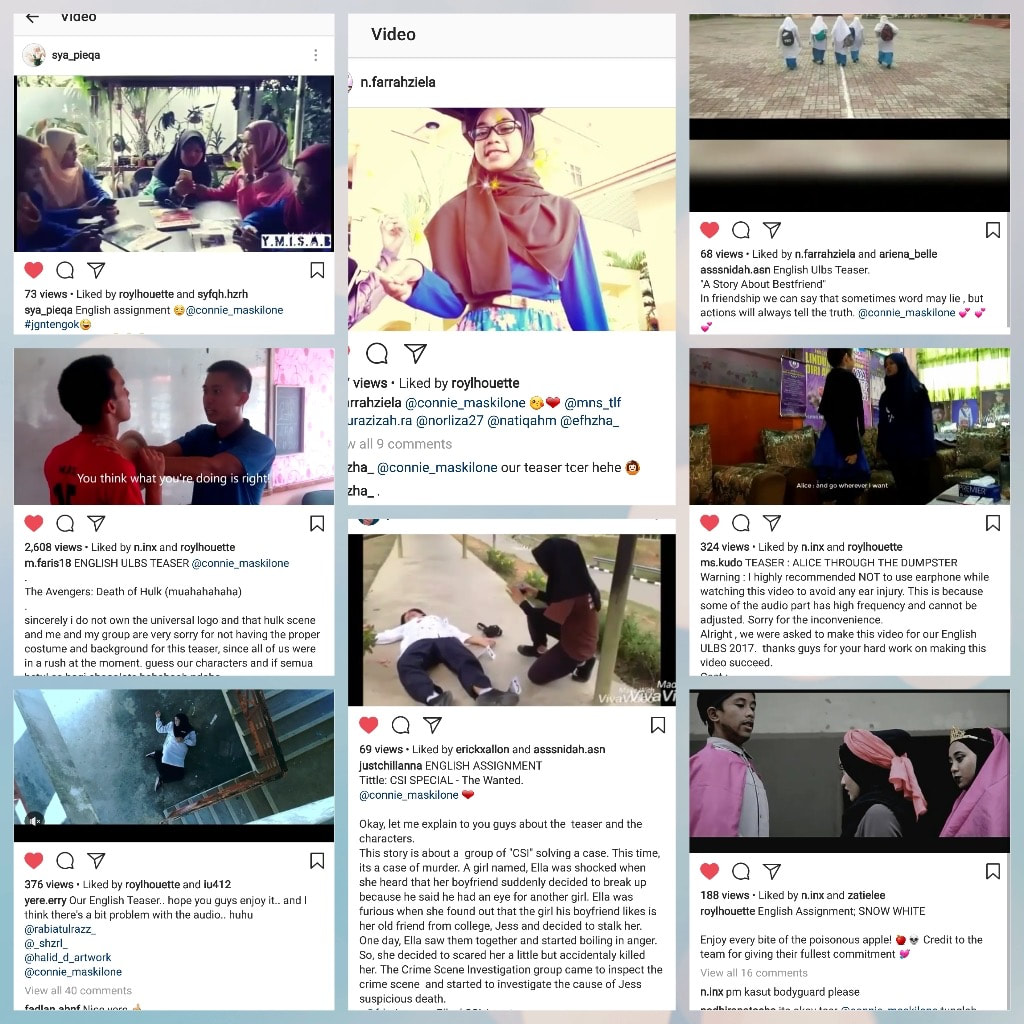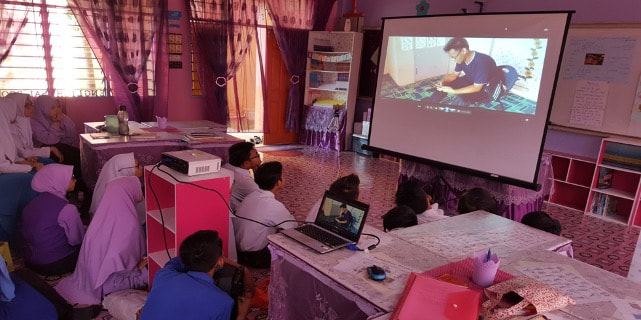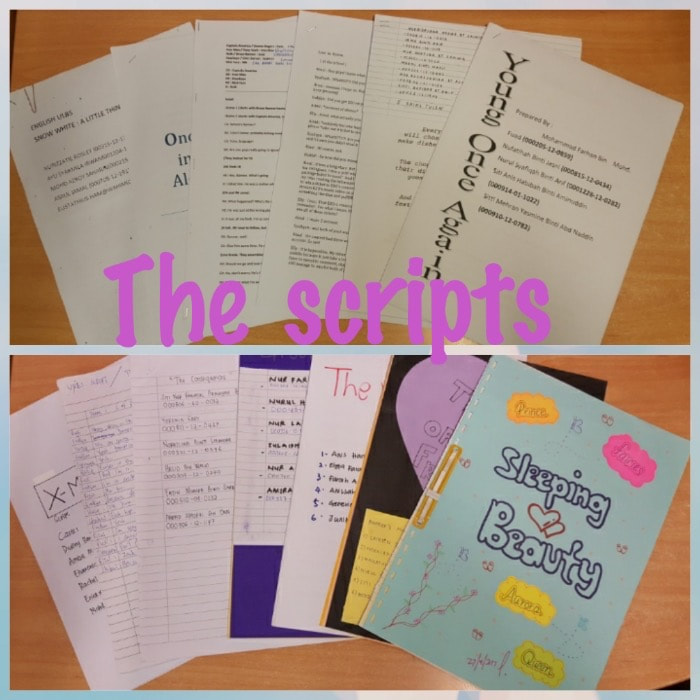|
by Connie Bernard Maskilone
Summary
My Form 5 students were always bored and lacking in enthusiasm when completing their tasks for the School-Based Oral Assessment (SBOA). This project was conducted as an intervention to encourage the Form 5 students of SMK Tebobon, Kota Kinabalu, Sabah to do their SBOA in fun and creative ways. Through observations and brainstorming of ideas conducted in the classroom, I discovered that the students were not interested in doing the oral test the ‘old’ ways. In this article, I would share how an Instagram video-making project can act as an intervention to make SBOA more engaging and interesting. The students’ performances in the progress test showed tremendous improvement, and the students were also able to complete their videos and scripts within the time frame given. The findings from this project suggest that the video-making and Instagram project was able to improve the students’ speaking skills and engage reluctant speakers to converse in the targeted language.
Background and Context
SBOA stands for School-Based Oral Assessment. It can be considered as Paper 3 for the English Language subject, which is a required subject in the Sijil Pelajaran Malaysia (SPM) examination. Students will have to go through three assessments. The first and second assessments are done when the students are in Form 4 while the third or final assessment is conducted in Form 5. It is compulsory for the Form 5 students to complete this assessment. Failure to do so can lead to the students being denied any grades for Paper 1 and Paper 2 for the English subject, as Paper 3 is a pre-requisite. For the third assessment, students are allowed to do their SBOA projects in groups. The teacher is given the autonomy to determine the types of projects and to provide guidelines. For my class, I decided to do a drama activity. I wanted the students to be able to act out their roles in the drama without referring to or reading from the prepared scripts. When I first did this in the classroom, the students were half-dead bored (have a look at the picture below and see if you agree with me).
As soon as the first group finished their presentation, I knew I was disappointed. This was not what I wanted, and I knew it was not what the students wanted, too. Their attitudes said it all. The performers were not focused and were totally unprepared. Members of the audience were busy chatting amongst them, and no one paid attention. Me? I was pretending to be engrossed in flipping the scripts from one page to another all throughout the performance, trying hard to hide the immense boredom and frustrations that were in my heart.
Since the first group’s drama performance did not seem to be working out as expected, I put a halt to the whole thing. I told the students that we would continue the SBOA the following day. When I reached home, I reflected on the failed drama session. Over steaming cup of sugarless green tea, I tried to nurse my disheartenment by scrolling through my mobile phone. Something caught my attention. My class was made up of a totally diverse group of 17-year-olds with multiple personalities and interests. But if there was anything that they all had in common, it was this: almost everyone had an Instagram account. Light-bulb moment! I knew there and then what I needed to do. The next day I broke the news. "There is a change of plan," I told them. "We are going to do this a little bit differently," I said. The students’ reactions were priceless. Instead of suppressed yawns and blank stares that I had gotten so used to after being in this profession for almost 20 years, my suggestion was greeted with cheers, laughs and giggles. The deafening silence of the classroom immediately turned into chaotic bursts of excitements. Introduction - The Planning Stage The preliminary focus of this project was to:
Objectives
Development and Implementation As this was my first grading-based project, my focus was to help the students improve their scores in SBOA. I hope this new way of assessing their speaking skills could motivate the students to speak more. At the same time, I could also make my lessons more interesting and fun. Since the traditional ways of doing drama in the classroom did not work out so well with the students, they were assigned to make a video of their drama performances. I would be grading them based on the video that they produced. To do this, I sought permission from the school for the students to bring into the classroom all the devices and gadgets they needed to complete the project, e.g. camera, mobile phones, etc. (Malaysian schools have strict policies regarding the use of mobile phones among students within the school compound). For safety purposes and to comply with the school rules, I would keep the students’ belongings safely after they were done using them, and would only return the stuffs to them at the end of the school session. The students were given three months to complete their project. Before coming up with a complete 15-minute video of their drama performance, each group would need to post a one-minute video on Instagram as a ‘teaser’ (see picture below - go to the end of this post to watch some of the videos). They needed to tag my Instagram account so I would be notified every time a video was uploaded. This would be considered as their progress test. That was how I kept track of their work. I would hit the ‘like’ button as a sign of approval to permit my students to move on to the next stage. This was the most interesting part as the students said that they had become ‘Insta-famous’ amongst their circle of friends. There would be times when I purposely delayed hitting the ‘like’ button, just to see how much the students cared. I was in for a pleasant surprise. My deliberate slow response prompted my students to keep sending me personal messages to remind me to hit the ‘like’ button. For me, this was very encouraging. Once they received a ‘like’ from me, the students would need to work on writing their scripts and to produce their 15-minute videos. In this video, each group member must speak for more than 10 times, progressively using longer and wider range of vocabulary. The videos and scripts would need to be submitted together for assessments. This is where the real grading work started. The final, and most anticipated moment after I was done with grading was the video-viewing session (see picture below). I think this was probably one of the most wonderful days in my life as a teacher, as my students seemed to be very happy and could not stop talking about their videos, and of course about their acting performances. They were clearly very proud of what they had achieved through this project. After the video-watching, I asked students for their feedback on the project. Overall, the students thought that the video-making and Instagram project:
Reflection
Enhanced comprehension led to improved confidence All students were able to finish their videos and scripts on time. Students were confident to speak with little to no hesitations. Feedbacks from the students were overwhelmingly positive. I compared the performances of the students before and after the intervention was conducted, and found out that most students showed improvements in their SBOA grades. The students communication skills had improved in leaps and bounds. Some students were unable to speak spontaneously and had to resort to memorisation instead. However, I am glad to know that at least this project helped the students understand what they were saying in the scenes of their dramas. The students shared with me that instead of just reading the script without understanding the context (like they used to when performing 'live' in front of their classmates), this project gave them the time to grasp the storyline as they thought about how a certain scene should unfold in the video, which angle should be captured, what soundtrack should be included, and how emotions should be highlighted through facial expressions and voice projections. This shows that the use of video-making and Instagram was effective in helping the students embody their roles in the drama, which eventually helped in enhancing speaking confidence and performances in SBOA. We were in this together In the first week of the project’s implementation, the students were so excited. Everyone was busy asking me questions such as what attires to wear and whether they had to put on a make-up. However, as the project progressed, the students became less focused on the video-making as they were struggling on the script-writing. But I was there for them all throughout, and all the videos and scripts were able to be completed within the allocated time. Many students started the project with some feelings of uncertainty as they knew they would be putting themselves out there. But as evidenced through the students’ performances in the ‘teaser’ videos posted on Instagram, I could sense changes in their perceptions of what it means to speak in front of an audience. It was also amazing to see the spirit of togetherness and team-work among the students. Not every one was in a possession of a mobile phone, but everyone was willing to share for the sake of this project. One of the students did not have an Instagram account, but his friends were kind enough to let him watch the videos through their accounts. The students' commitments were just amazing, and I could not be more proud. It was a win for the teacher, too! I believe this new method of assessment is also a helpful strategy to ease my burdens of assessing, as I did not have to remain seated for hours in the classroom to watch the students’ performances in order to award them marks for their SBOA. I could do my grading at the comfort of my own living room, over my favourite cup of sugarless green tea. Revision - What’s Next? Personally, I have experienced positive changes in my ways of teaching, and my students’ learning in the classroom. I will continue to use this strategy, and I hope to include more apps and tools in future lessons. Apart from that, giving my students the chance to offer suggestions on how they want to learn the English language is going to be a permanent feature of my approach, whether inside or outside the classroom. I will work on continually improving my teaching strategies so I can cater for the needs of my 21st century learners. I also aim to continue working on interventions that can make learning more interesting, meaningful and fun for my students. If my experiences can serve as inspirations for other teachers, that would be a great bonus.
The students who worked on this project had graduated from SMK Tebobon. Many are currently in colleges and universities, while some are already working. I have asked for permission to share their wonderful works so people can see how creative they are! I am so glad that they agreed.
Below are some of the students' one-minute 'teaser' videos. Enjoy!
References / Useful Links
Connie did another project using Instagram to make learning English idioms more fun for her students. Read all about it here. Published on: 6 November 2020 AuthorConnie Bernard Maskilone graduated from Malaysia Teachers Training College in 1996. She obtained her B.Ed (Hons) TESL from University Malaysia Sabah in 2005. Connie wrote this piece when she was working at SMK Tebobon in Kota Kinabalu as the Head of English Panel. She is currently teaching in Sabah Malaysian Sports School. Despite considering herself as a late bloomer in the field of digital technology, she is keen to discover its tremendous educational potentials.
Want to write for us? Send us a message.
2 Comments
julius rennjennings
4/10/2021 04:23:47 am
just to say I've enjoyed reading your blog
Reply
Leave a Reply. |
Categories
All
|





